Effect of Sodium Hydroxide, Succinic Acid and Their Combination on Densified Wood Properties
Abstract
1. Introduction
2. Materials and Methods
2.1. Sample Preparation
2.2. Densification Process with Alkalis, Acids and Their Combination as Pre-Treatments
2.3. Measurement of Specific Gravity (SG)
2.4. Stress–Strain Observation
2.5. Measurement of Weight Percent Gain (WPG)
2.6. Measurement of the Compression Set (C-Set)
2.7. Measurement of Compression-Set Recovery (CSR) and Water Absorption (WA)
2.8. Fourier-Transform Infrared (FTIR) Spectroscopy Observation
2.9. Statistical Analysis
3. Results
3.1. Specific Gravity Improvement of Densified Wood under Several Treatment Categories
3.2. Compression-Set Recovery and Water Absorption of Densified Wood under Several Treatment Categories
3.3. Chemical Changes to Densified Wood under Several Treatment Categories
4. Conclusions
Author Contributions
Funding
Institutional Review Board Statement
Informed Consent Statement
Data Availability Statement
Acknowledgments
Conflicts of Interest
References
- Inoue, M.; Norimoto, M.; Otsuka, Y.; Yamada, T. Surface compression of coniferous wood lumber II: Permanent set of compression wood by low molecular weight phenolic resin and some physical properties of the products. Mokuzai. Gakkaishi. 1991, 35, 227–233. [Google Scholar]
- Kutnar, A.; Kamke, F.A.; Sernek, M. Density profile and morphology of viscoelastic thermal compressed wood. Wood Sci. Technol. 2009, 43, 57–68. [Google Scholar] [CrossRef]
- Tu, D.; Su, T.; Zhang, T.; Fan, W.; Zhou, Q. Thermo-mechanical densification of Populus tomentosa ver. Tomentosa with low moisture content. BioResources 2014, 9, 3846–3856. [Google Scholar] [CrossRef]
- Pelit, H.; Yalçin, M. Resistance of mechanically densified and thermally post-treated pine sapwood to wood decay fungi. J. Wood Sci. 2017, 63, 514–522. [Google Scholar] [CrossRef][Green Version]
- Skyba, O.; Schwarze, F.W.R.M. Physical and mechanical properties of thermo-hygro-mechanically (THM)-densified wood. Wood Res. 2009, 54, 1–18. [Google Scholar]
- Fang, C.H.; Mariotti, N.; Cloutier, A.; Koubaa, A.; Blanchet, P. Densification of wood veneers by compression combined with heat and steam. Eur. J. Wood Prod. 2011, 70, 155–163. [Google Scholar] [CrossRef]
- Neyses, B. Surface Densification of Solid Wood: Paving the Way towards Industrial Implementation; Luleå University of Technology: Luleå, Sweden, 2019; p. 224. [Google Scholar]
- Sözbir, G.D.; Bektaş, I.; Ak, A.K. Influence of combined heat treatment and densification on mechanical properties of poplar wood. Maderas. Cienc. Tecnol. 2019, 21, 481–492. [Google Scholar] [CrossRef]
- Sadatnezhad, S.H.; Khazaeian, A.; Sandberg, D.; Tabarsa, T. Continuous surface densification of wood: A new concept for large-scale industrial processing. BioResources 2017, 12, 3122–3132. [Google Scholar] [CrossRef]
- Rautkari, L.; Properzi, M.; Pichelin, F.; Hughes, M. Properties and set-recovery of surface densified Norway spruce and European beech. Wood Sci. Technol. 2010, 44, 679–691. [Google Scholar] [CrossRef]
- Augustina, S. Sifat Dasar Tiga Jenis Kayu Lesser-Used Species dan Peningkatan Mutunya Melalui Teknik Densifikasi. Master’s Thesis, IPB University, Bogor Regency, Indonesia, 2019; pp. 1–45. (In Bahasa). [Google Scholar]
- Augustina, S.; Wahyudi, I.; Darmawan, I.W.; Malik, J.; Basri, E.; Kojima, Y. Specific gravity and dimensional stability of boron-densified wood on three lesser-used species from Indonesia. J. Korean Wood Sci. Technol. 2020, 48, 458–471. [Google Scholar] [CrossRef]
- Wang, F.; Zhou, S.; Li, L.; Zhang, X. Changes in the morphological-mechanical properties and thermal stability of bamboo fibers during the processing of alkali treatment. Polym. Compos. 2017, 39, E1421–E1428. [Google Scholar] [CrossRef]
- Chen, H.; Zhang, W.; Wang, X.; Wang, H.; Wu, Y.; Zhong, T.; Fei, B. Effect of alkali treatment on wettability and thermal stability of individual bamboo fibers. J. Wood Sci. 2018, 64, 398–405. [Google Scholar] [CrossRef]
- Doczekalska, B.; Bartkowiak, M.; Zakrzewski, R. Esterification of willow wood with cyclic acid anhydride. Wood Res. 2014, 59, 85–96. [Google Scholar]
- Zhang, X.; Wang, F.; Keer, L.M. Influence of surface modification on the microstructure and thermo-mechanical properties of bamboo fibers. Materials 2015, 8, 6597–6608. [Google Scholar] [CrossRef]
- Chen, H.; Yu, Y.; Zhong, T.; Wu, Y.; Li, Y.; Wu, Z.; Fei, B. Effect of alkali treatment on microstructure and mechanical properties of individual bamboo fibers. Cellulose 2016, 24, 333–347. [Google Scholar] [CrossRef]
- Xu, E.; Wang, D.; Lin, L. Chemical structure and mechanical properties of wood cell walls treated with acid and alkali solution. Forests 2020, 11, 87. [Google Scholar] [CrossRef]
- Song, J.; Chen, C.; Zhu, S.; Zhu, M.; Dai, J.; Ray, U.; Li, Y.; Kuang, Y.; Li, Y.; Quispe, N.; et al. Processing bulk natural wood into a high-performance structural material. Nature 2018, 554, 224–228. [Google Scholar] [CrossRef]
- Merrylin, J.; Kannah, R.Y.; Banu, J.R.; Yeom, I.T. Food Waste to Valuable Resources: Production of Organic Acids and Enzymes/Biocatalysts from Food Waste; Academic Press: Boston, MA, USA, 2020; pp. 119–141. [Google Scholar]
- Zeikus, J.G.; Jain, M.K.; Elankovan, P. Biotechnology of succinic acid production and markets for derived industrial products. Appl. Microbiol. Biotechnol. 1999, 51, 545–552. [Google Scholar] [CrossRef]
- Urbance, S.E.; Pometto, A.L., III; DISpirito, A.A.; Demirci, A. Medium evaluation and plastic composite support ingredient selection for biofilm formation and succinic acid production by Actinobacillus succinogenes. Food Biotech. 2003, 17, 53–65. [Google Scholar] [CrossRef]
- Nghiem, N.P.; Kleff, S.; Schwegmann, S. Succinic acid: Technology development and commercialization. Fermentation 2017, 3, 26. [Google Scholar] [CrossRef]
- Borges, E.R.; Pereira, N. Succinic acid production from sugarcane bagasse hemicellulose hydrolysate by Actinobacillus succinogenes. J. Ind. Microbiol. Biotechnol. 2011, 38, 1001–1011. [Google Scholar] [CrossRef] [PubMed]
- Jiang, M.; Ma, J.; Wu, M.; Liu, R.; Liang, L.; Xin, F.; Zhang, W.; Jia, H.; Dong, W. Progress of succinic acid production from renewable resources: Metabolic and fermentation strategies. Biores. Technol. 2017, 245, 1710–1717. [Google Scholar] [CrossRef] [PubMed]
- Wang, J.; Fishwild, S.J.; Begel, M.; Zhu, J.Y. Properties of densified poplar wood through partial delignification with alkali and acid pretreatment. J. Mater. Sci. 2020, 55, 14664–14676. [Google Scholar] [CrossRef]
- Chi, C.; Hui, Z.; Liu, M.; Zhang, S.; Gong, Y. Effect of acetic acid pretreatment on wood pore structure and fractal dimension. BioResources 2017, 12, 3905–3917. [Google Scholar] [CrossRef]
- Wang, J.; Liu, J.; Li, J.; Zhu, J.Y. Characterization of microstructure, chemical, and physical properties of delignified and densified poplar wood. Materials 2021, 14, 5709. [Google Scholar] [CrossRef]
- Augustina, S.; Wahyudi, I.; Darmawan, I.W.; Malik, J. Ciri anatomi, morfologi serat, dan sifat fisis tiga jenis lesser-used wood species asal Kalimantan Utara, Indonesia. JIPI 2020, 25, 599–609. (In Bahasa) [Google Scholar] [CrossRef]
- Augustina, S. Peningkatan Mutu Beberapa Lesser-Used Wood Species Melalui Teknik Impregnasi dan Kompregnasi. Doctoral Dissertation, IPB University, Bogor Regency, Indonesia, 2021; pp. 1–93. (In Bahasa). [Google Scholar]
- Augustina, S.; Wahyudi, I.; Darmawan, W.; Malik, J.; Okano, N.; Okada, T.; Murayama, K.; Kobori, H.; Kojima, Y.; Suzuki, S. Selected properties of compregnated wood using low molecular weight phenol formaldehyde and succinic anhydride. Wood Res. 2021, 66, 762–776. [Google Scholar] [CrossRef]
- Darwis, A.; Wahyudi, I.; Dwianto, W.; Cahyono, T.D. Densified wood anatomical structure and the effect of heat treatment on the recovery of set. J. Ind. Acad. Wood Sci. 2017, 14, 24–31. [Google Scholar] [CrossRef]
- Bao, M.; Huang, X.; Jiang, M.; Yu, W.; Yu, Y. Effect of thermos‒hydro‒mechanical densification on microstructure and properties of poplar wood (Populus tomentosa). J. Wood Sci. 2017, 63, 591–605. [Google Scholar] [CrossRef]
- Ellis, S.; Steiner, P. The behaviour of five wood species in compression. IAWA 2002, 23, 201–211. [Google Scholar] [CrossRef]
- Nur, I.F.A.; Zaidon, A.; Rabia’tol, A.M.A.; Bakar, E.S.; Paridah, M.T.; Mohd, H.S.; Anwar, U.M.K. Enhancing the properties of low-density hardwood Dyera costulata through impregnation with phenolic resin admixed with formaldehyde scavenger. J. Appl. Sci. 2011, 11, 3474–3481. [Google Scholar]
- Zimmerman, T.; Richter, K.; Bordeanu, N. Arrangement of cell-wall constituents in chemically treated Norway spruce tracheids. Wood Fiber Sci. 2007, 39, 221–231. [Google Scholar]
- Mittal, J.; Mathur, R.B.; Bahl, O.P.; Inagaki, M. Post-spinning treatment of pan fibers using succinic acid to produce high performance carbon fiber. Carbon 1998, 36, 893–897. [Google Scholar] [CrossRef]
- Yew, B.S.; Muhamad, M.; Mohamed, S.B.; Wee, F.H. Effect of alkaline treatment on structural characterization, thermal degradation, and water absorption ability of coir fibre polymer composites. Sains Malays. 2019, 48, 653–659. [Google Scholar] [CrossRef]
- Shi, J.; Peng, J.; Huang, Q.; Cai, L.; Shi, S.Q. Fabrication of densified wood via synergy of chemical pre-treatment, hot-pressing and post mechanical fixation. J. Wood Sci. 2020, 66, 5. [Google Scholar] [CrossRef]
- Feng, L.; Berglund, K.A. ATR-FTIR for determining optimal cooling curves for batch crystallization of succinic acid. Cryst. Growth Des. 2002, 2, 449–452. [Google Scholar] [CrossRef]
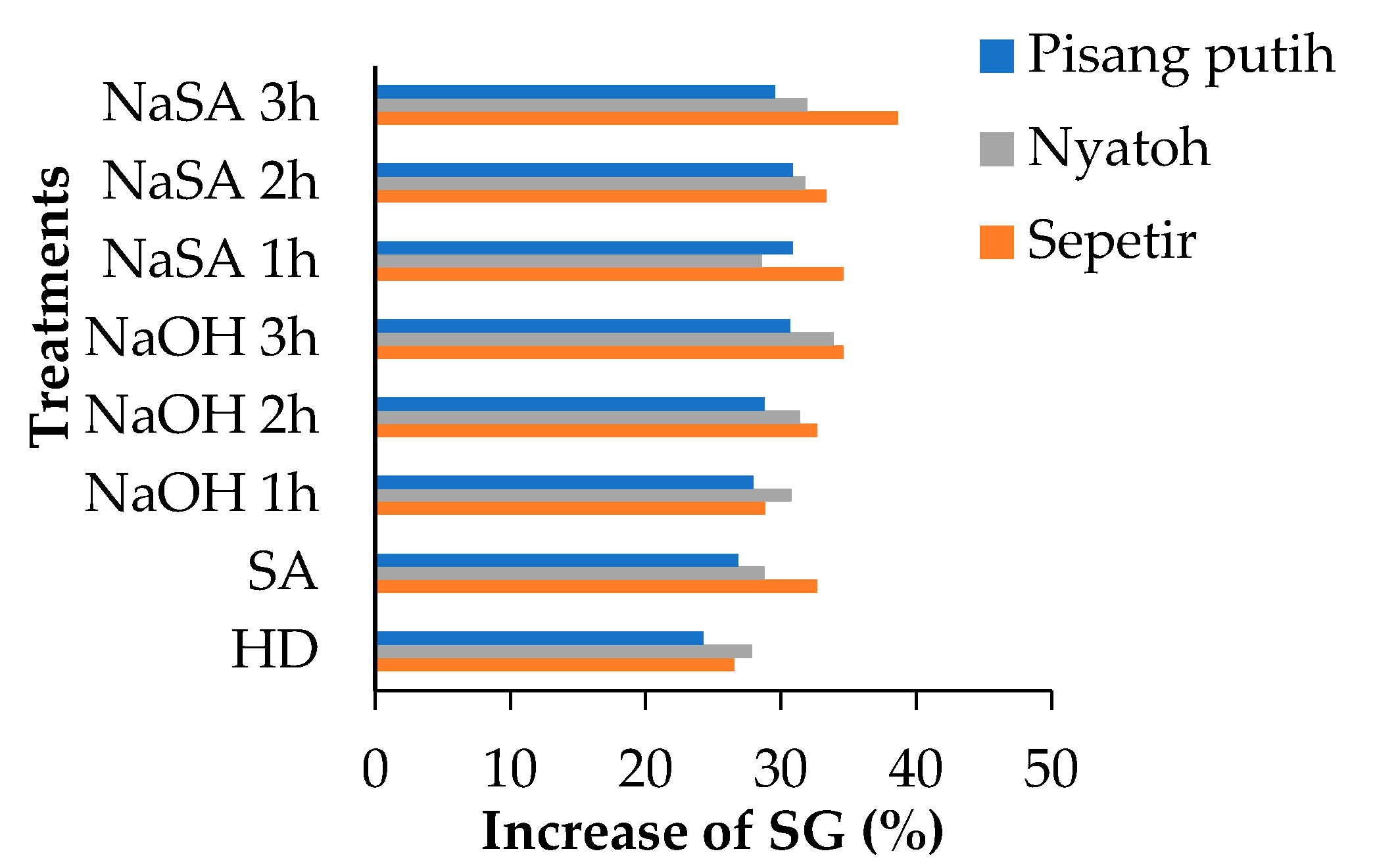
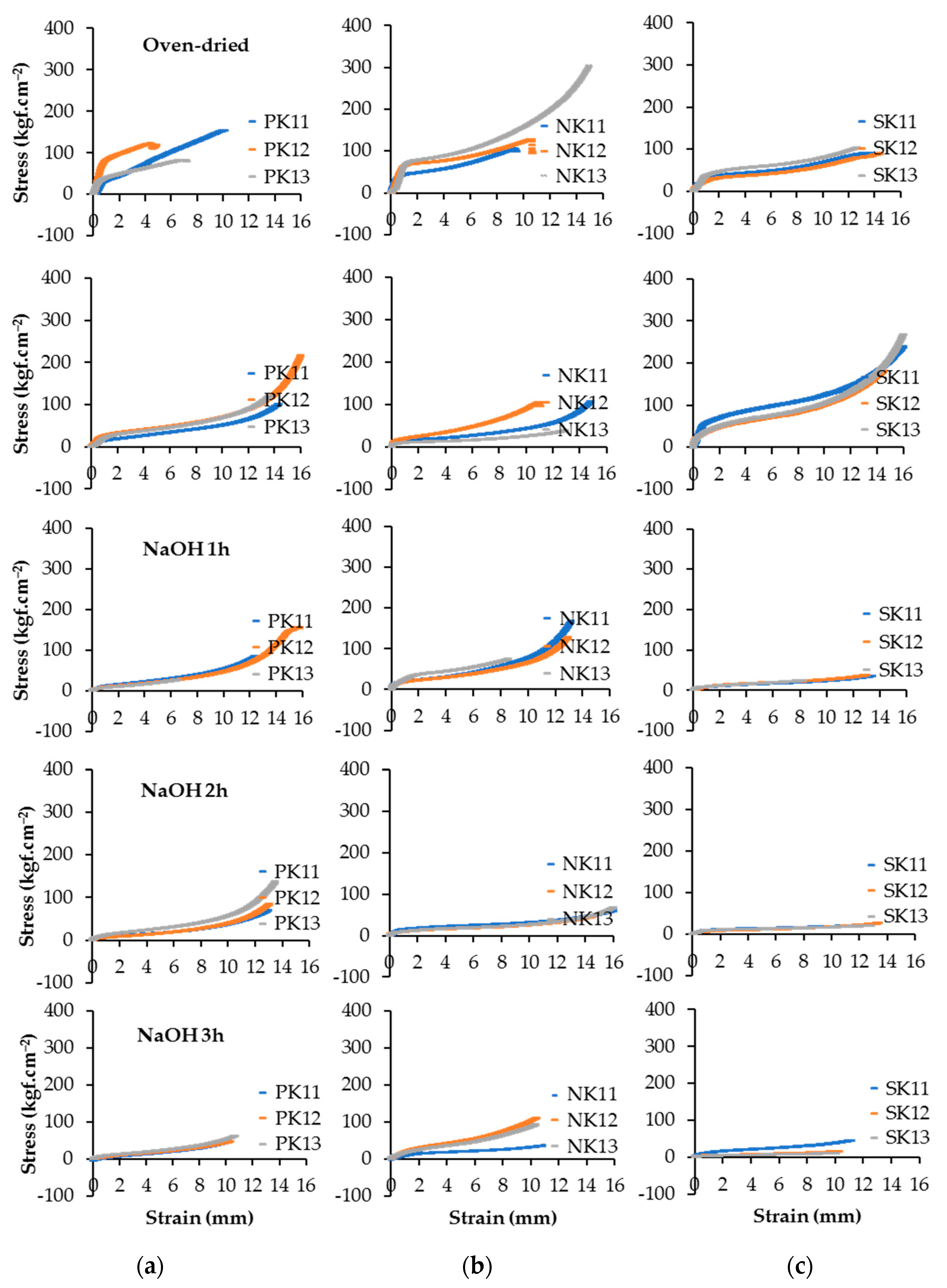
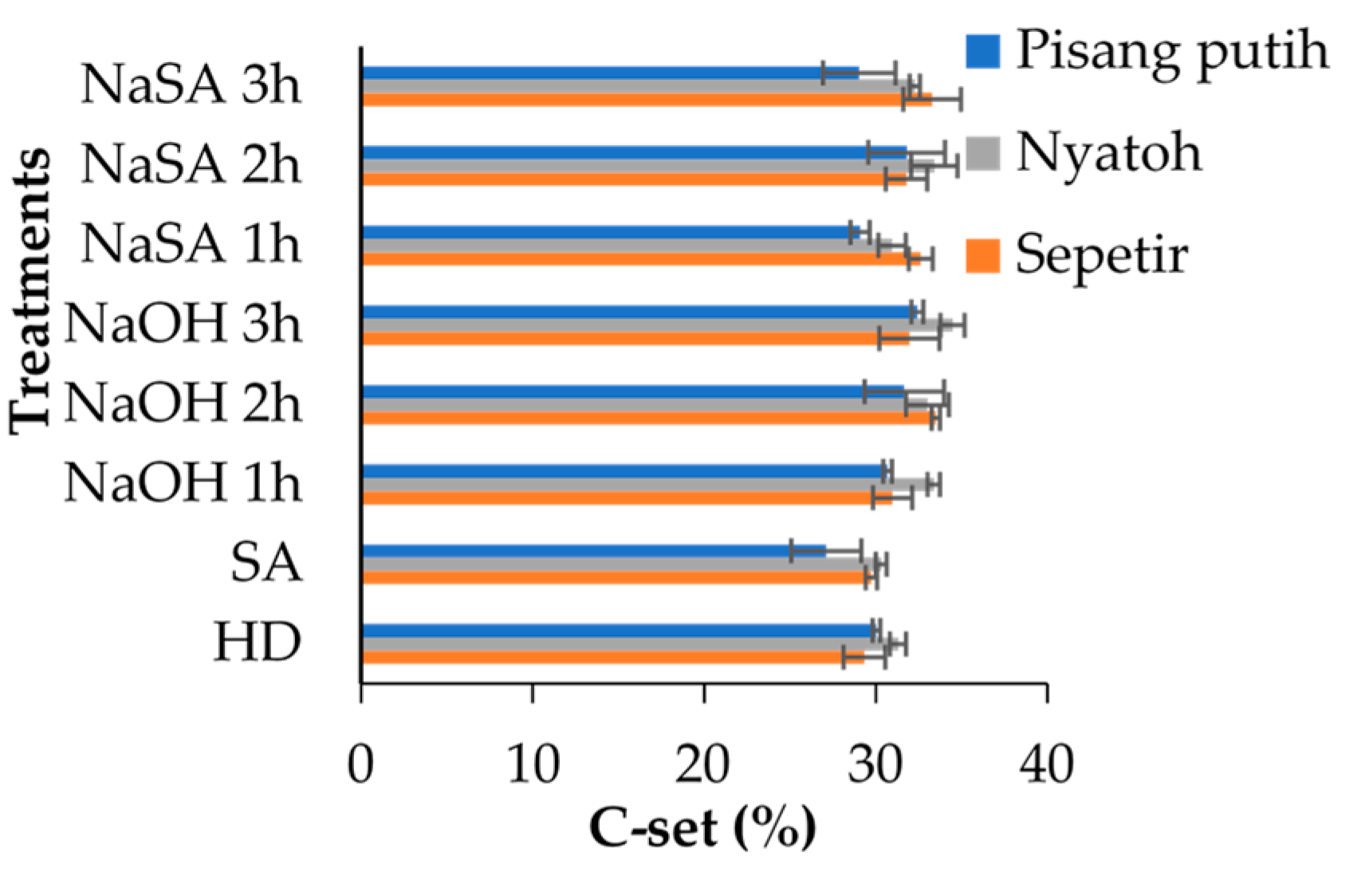
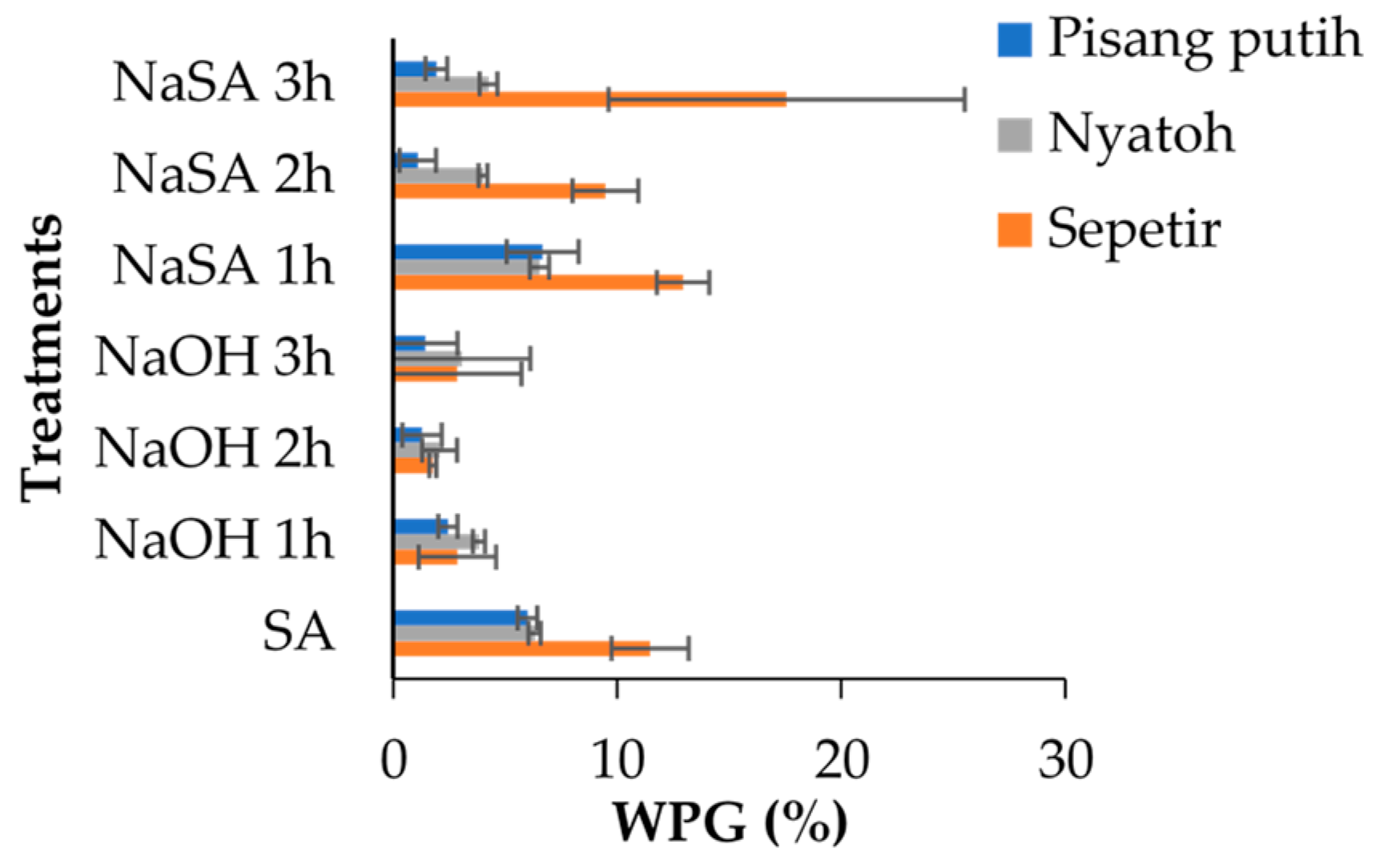
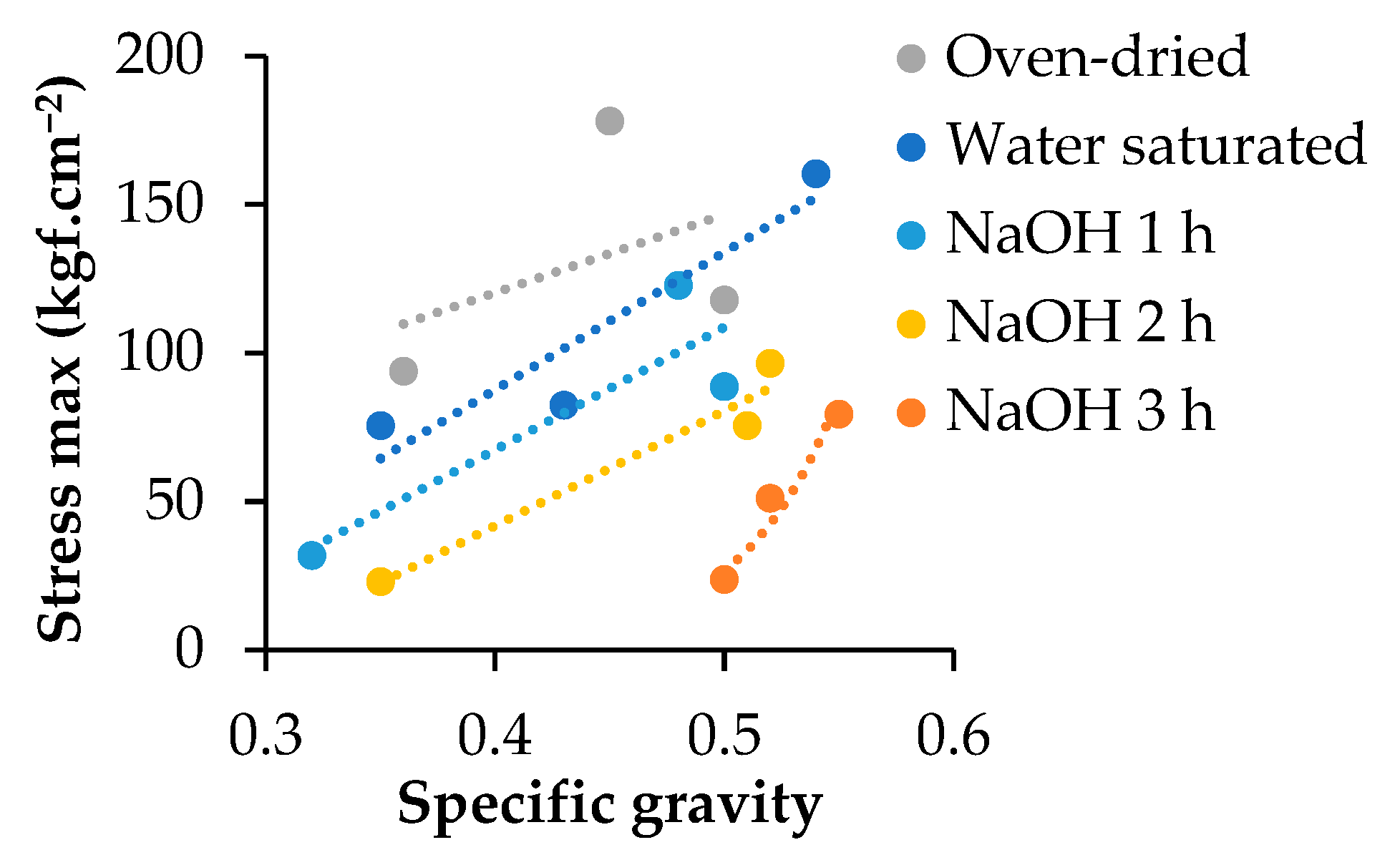

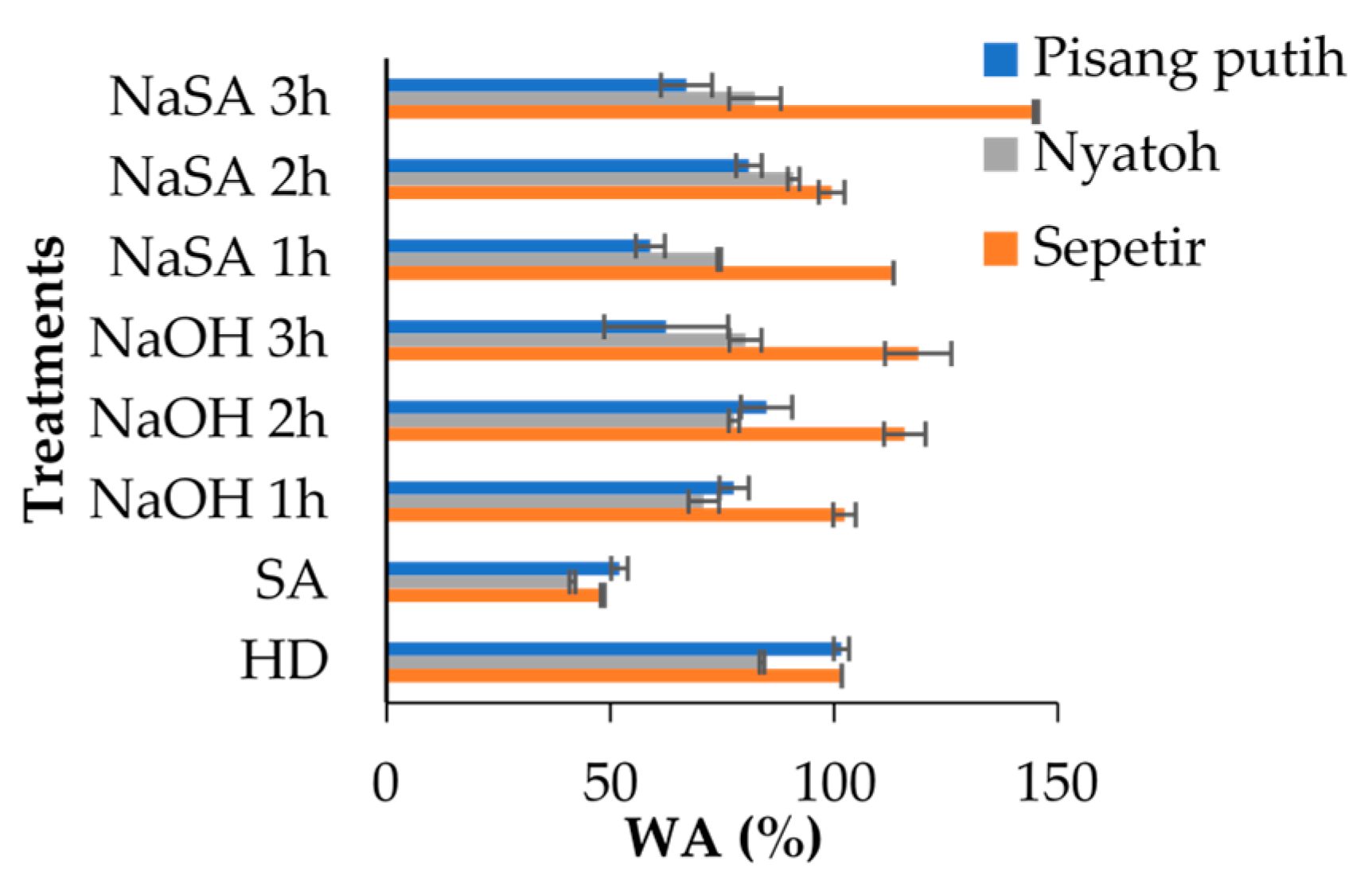

| Treatments | Code | Size (cm3) |
|---|---|---|
| Untreated | C | 2 × 2 × 2 |
| Oven-dried then hot pressed | HD | 2 × 2 × 2.8 |
| Impregnated with 10% succinic acid then hot pressed | SA | 2 × 2 × 2.8 |
| Soaked within 10% NaOH for 1 h then hot pressed | NaOH 1 h | 2 × 2 × 2.8 |
| Soaked within 10% NaOH for 2 h then hot pressed | NaOH 2 h | 2 × 2 × 2.8 |
| Soaked within 10% NaOH for 3 h then hot pressed | NaOH 3 h | 2 × 2 × 2.8 |
| Soaked within 10% NaOH for 1 h, impregnated by 10% SA then hot pressed | NaSA 1 h | 2 × 2 × 2.8 |
| Soaked within 10% NaOH for 2 h, impregnated by 10% SA then hot pressed | NaSA 2 h | 2 × 2 × 2.8 |
| Soaked within 10% NaOH for 3 h, impregnated by 10% SA then hot pressed | NaSA 3 h | 2 × 2 × 2.8 |
| Treatment Category | Wood Species | |||||
|---|---|---|---|---|---|---|
| Pisang Putih | Nyatoh | Sepetir | ||||
| Before | After | Before | After | Before | After | |
| Untreated | 0.52 ± 0.04 cd | 0.44 ± 0.01 bc | 0.35 ± 0.01 a | |||
| HD | 0.53 ± 0.01 | 0.70 ± 0.01 ghi | 0.44 ± 0.03 | 0.61 ± 0.05 e | 0.36 ± 0.01 | 0.49 ± 0.01 bcd |
| SA | 0.49 ± 0.02 | 0.67 ± 0.01 efghi | 0.52 ± 0.02 | 0.73 ± 0.02 hi | 0.35 ± 0.03 | 0.52 ± 0.04 d |
| NaOH 1 h | 0.49 ± 0.03 | 0.68 ± 0.03 efghi | 0.45 ± 0.01 | 0.65 ± 0.02 efg | 0.37 ± 0.01 | 0.52 ± 0.02 d |
| NaOH 2 h | 0.47 ± 0.05 | 0.66 ± 0.05 efgh | 0.48 ± 0.07 | 0.70 ± 0.09 fghi | 0.35 ± 0.01 | 0.52 ± 0.02 d |
| NaOH 3 h | 0.52 ± 0.04 | 0.75 ± 0.04 i | 0.41 ± 0.02 | 0.62 ± 0.02 ef | 0.34 ± 0.02 | 0.52 ± 0.02 cd |
| NaSA 1 h | 0.47 ± 0.06 | 0.68 ± 0.07 efghi | 0.50 ± 0.01 | 0.70 ± 0.01 fghi | 0.34 ± 0.01 | 0.52 ± 0.01 d |
| NaSA 2 h | 0.47 ± 0.04 | 0.68 ± 0.03 efghi | 0.45 ± 0.03 | 0.66 ± 0.03 efgh | 0.34 ± 0.00 | 0.51 ± 0.01 bcd |
| NaSA 3 h | 0.50 ± 0.01 | 0.71 ± 0.02 ghi | 0.49 ± 0.01 | 0.72 ± 0.02 ghi | 0.27 ± 0.09 | 0.44 ± 0.11 b |
| Parameter | Factors | ||||||
|---|---|---|---|---|---|---|---|
| JK | PT | DP | JK × PT | JK × DP | PT × DP | JK × PT × DP | |
| Specific gravity | ** | ** | ns | ** | * | ns | * |
| C-set | ** | ** | ** | ** | ns | ns | ** |
| WPG | ** | ** | ** | ** | ** | ns | * |
| CSR | ** | ** | ** | ** | ** | ** | * |
| Water absorption | ** | ** | * | ns | ** | ns | * |
Publisher’s Note: MDPI stays neutral with regard to jurisdictional claims in published maps and institutional affiliations. |
© 2022 by the authors. Licensee MDPI, Basel, Switzerland. This article is an open access article distributed under the terms and conditions of the Creative Commons Attribution (CC BY) license (https://creativecommons.org/licenses/by/4.0/).
Share and Cite
Augustina, S.; Wahyudi, I.; Dwianto, W.; Darmawan, T. Effect of Sodium Hydroxide, Succinic Acid and Their Combination on Densified Wood Properties. Forests 2022, 13, 293. https://doi.org/10.3390/f13020293
Augustina S, Wahyudi I, Dwianto W, Darmawan T. Effect of Sodium Hydroxide, Succinic Acid and Their Combination on Densified Wood Properties. Forests. 2022; 13(2):293. https://doi.org/10.3390/f13020293
Chicago/Turabian StyleAugustina, Sarah, Imam Wahyudi, Wahyu Dwianto, and Teguh Darmawan. 2022. "Effect of Sodium Hydroxide, Succinic Acid and Their Combination on Densified Wood Properties" Forests 13, no. 2: 293. https://doi.org/10.3390/f13020293
APA StyleAugustina, S., Wahyudi, I., Dwianto, W., & Darmawan, T. (2022). Effect of Sodium Hydroxide, Succinic Acid and Their Combination on Densified Wood Properties. Forests, 13(2), 293. https://doi.org/10.3390/f13020293






